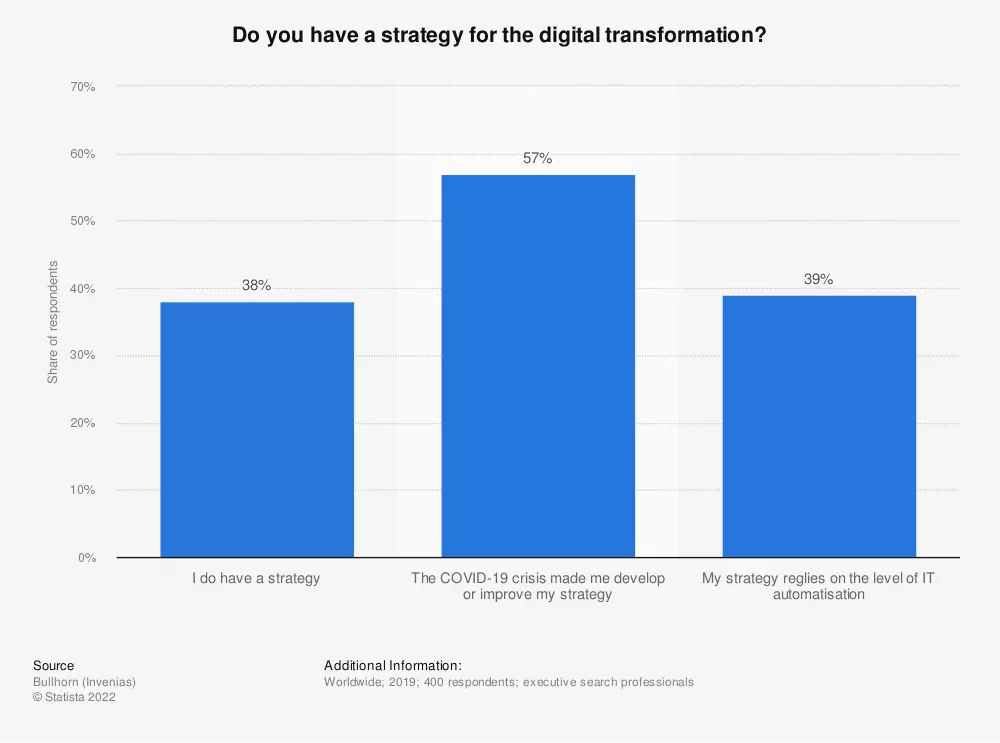Carving a roadmap to Digital Transformation
- Home
- Blog Details

- June 30 2022
- admin
Do you have a strategy for digital transformation? According to a Statista survey published in 2021, about 60 percent of executive search firms declared that they had implemented a digital transformation strategy or improved their efforts in developing one due to the effects of the COVID-19 crisis.

But before you can build a digital transformation strategy, you must establish a foundation. If your retail business operates both in physical stores and online, you must invest in the capability of the online channel to improve the customer experience. Invest in tools that map the user journey and resources to collect data. Moreover, your roadmap should include all the challenges that will come up along the way. Please go through some of the common roadblocks faced by companies undergoing digital transformation and the steps to overcome them.
Creating a digital transformation roadmap
It is essential to create a step-by-step roadmap to digital transformation that will provide clear directions and a clear destination. While there are many factors to consider when determining the best way to drive digital transformation, team alignment is one of the most important. The people responsible for executing the business strategy must share the vision and embrace open communication. Failure to be specific about the transformation details will leave things to chance and lead to misguided initiatives. A well-developed digital transformation roadmap should focus on integration and alignment. All stakeholders must be on the same page, and the technology must be integrated with existing systems and processes. In the digital age, companies can’t afford to have one piecemeal approach because it can leave gaps in security and undermine the overall goal. A comprehensive roadmap integrates technologies, software, and processes to maximize the chances of success. A digital transformation strategy aims to eliminate inefficiencies, improve customer service, and increase revenue.
It is important to remember that digital transformation is a process that takes years to complete. While the result may differ for each company, it will help to have a general idea of how to approach the process and plan accordingly. For example, the end goal should be “Point B” in the roadmap, while the next step is to fill in the gaps between where the company currently is and where it wants to be.
SWOT analysis
Next, you need to consider your competitive position and identify the challenges ahead. While it’s essential to be realistic when determining your competition’s strengths, identifying threats is equally important. Keeping rose-colored glasses on will prevent you from making the best strategic decisions. However, assessing threats is key to your business’s digital transformation success. Make sure you’re honest and objective in evaluating the current position of your business.
Using SWOT analysis in the context of digital transformation can effectively help your office transition. To create a successful SWOT analysis, you’ll need a diverse team composed of executive and mid-level employees. Include people from various departments so everyone can contribute their knowledge and expertise. The more varied the team, the less likely it will be to make a mistake. The best approach is to separate internal and external strengths and identify what your business can do to take advantage of them. The most effective way to identify internal and external strengths and weaknesses are to divide the categories by controllable and uncontrollable factors. It will help you make a more accurate SWOT analysis. The main mistake people make is to confound weaknesses and opportunities and make the SWOT analysis process more difficult. Once you have done this, you’ll be better prepared to determine what your next steps should be.
A proper SWOT analysis can help you identify your company’s strengths, weaknesses, opportunities, and threats. It can also help you determine how to capitalize on these factors to strengthen your competitive position. Performing a SWOT analysis can help you formulate wise business strategies that will boost your company’s competitiveness and position in the market. It’s also a good idea to consider external factors like population growth, competitive trends, and economic climate, as they can affect your company’s ability to compete. If you haven’t incorporated SWOT analysis yet, it’s time to do so.
Defining mini-projects
Creating a digital transformation initiative roadmap should start with defining the key activities. These activities include technology projects, supplier ecosystem changes, and business process modifications. It should also identify high-level cost-benefit projections for each activity. Then, define each activity on the roadmap as a mini-project. By defining these mini-projects, the roadmap can be used as a guide to determine which activities are the most critical and which ones are not.
Clearly define the goals and objectives for each mini-project. Identify the purposes and responsibilities of each team member. Determine how each member of the team will contribute to the project. Make sure they are aligned with the overall strategy. Assign roles to individuals, assign responsibility for specific tasks, and set milestones for success. After each project is completed, evaluate results, and determine if the project has met expectations.
Identifying challenges along the way
Businesses may face many challenges while embarking on a digital transformation journey. They may lack the skills and resources to implement a full-fledged digital strategy. Assessing an organization’s readiness for digital transformation is necessary to avoid getting stuck in a rut. While the organization may be reluctant to use new technologies and processes, it may still be able to work with early adopters that are prepared to implement these technologies in operations.
As companies begin their digital transformation journey, they should analyze the data collected by their existing processes and measure the impact of these changes on their business. Data analysis should be conducted to identify trends and patterns. For example, some prominent OEMs produce enhanced equipment that can improve fuel efficiency, predict downtime, and streamline maintenance processes. These advanced features are known as Equipment-as-a-Service (EaaS). Embedding digital technology within an organization requires the buy-in of every employee, including those in remote locations. It presents some unique challenges during the roll-out process, particularly when companies have a distributed workforce. These workers typically have different corporate cultures and processes. To overcome these obstacles, organizations should promote the new technology and change, set expectations, and provide ongoing self-service and live session training.
Define Corporate Values
Ultimately, a digital transformation should be able to spread itself throughout the company. It would be best if you redefined your corporate values to make digital transformation a success for your company. Reinforcing the corporate values will help you navigate new opportunities in a multi-chapter organization. Reinforcing corporate values is vital to unlocking the best talent and fulfilling the mission. The parent organization must collaborate with local chapters to define the organizational matters and develop a step-by-step roadmap to digital transformation.
Despite the benefits of digital transformation, many challenges are not obvious. Some of these are easily visible, while others are not. Some of these challenges include the ability to adapt to a new way of working, a desire to control the process, and the fear of change itself. Often, organizations should start small and then work up from there. The best-performing companies are those that accept the risks of change and embrace them. They do not impose a single leader who sets the tone. The leadership of a successful company will actively encourage discussion and change throughout the organization. They remove barriers and create an environment that fosters new ideas. Leadership isn’t about controlling or imposing a particular way of working but enabling.
We can guide towards a successful Digital Transformation
Prescient Technology has a team of industry experts with an in-depth experience is guiding companies realize their digital transformation goals. We are glad to answer your queries if you get in touch with us today.

